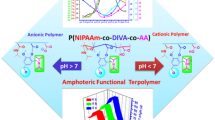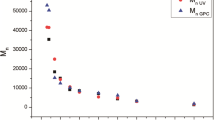Abstract
In this study, a novel pH-sensitive and reversible water-soluble polymer(PABC) forming aqueous two-phase systems(ATPS) was synthesized by using 2-(dimethylamino)ethyl methacrylate, t-butyl methacrylate, and methyl methacrylate as monomers and 2,2′-azo-bis-isobutyronitrile as initiator. The PABC could be recovered by adjusting isoelectric point (PI) to 8.4, and recovery at PI could reach 95%. ATPS was formed by 5% (w/w) PABC and 10% (w/w) PEG20000. The partition coefficient K of lysozyme was 6.8, and the partition coefficient K of bovine serum albumin could reach 12.5 in the ATPS.











Similar content being viewed by others
References
Kula, M. R., Kroner, K. H., & Hustedt, H. (1982). Purification of enzymes by liquid–liquid extraction. Advances in Biochemical Engineering, 24, 73.
Albertsson, P. A. (1986). Partitioning of cell particles and macro- molecules (3rd ed.). New York: Wiley–Interscience.
Tan, Q., Lin, J., Xiao, C., & Hao, S. (2003). Development and application of aqueous two-phase system extraction. Chemical Production and Technology, 10(1), 19–23.
Berggren, K., Johansson, H. O., & Tjerneld, F. (1995). Effects of salts and the surface hydrophobicity of proteins on partitions in aqueous two-phase systems containing thermoseparating ethylene oxide-propylene oxide copolymers. Journal of Chromatography A, 718, 67–69.
Persson, J., Nystrom, L., Ageland, H., & Tjermeld, F. (1998). Purification of recombinant apolipoprotein A-1 Milano expressed in Escherichia coli using aqueous two-phase extraction followed by temperature inducing phase separation. Journal of Chromatography B, 711, 97–109.
Johansson, H. O., Persson, J., & Tjerneld, F. (1999). Thermoseparating water/polymer system: A novel one-polymer aqueous two-phase system for protein purification. Biotechnology and Bioengineering, 66(4), 247–257.
Persson, J., Johansson, H. O., & Tjerneld, F. (1999). Purification of protein and recycling of polymers in a new aqueous two-pHase system using two thermoseparating polymers. Journal of Chromatography A, 864, 31–48.
Mos, V. B., Karel, C. A. M. L., & Lunk, A. M. V. D. W. (1998). Poly(ethylene glycol)–salt aqueous two-phase systems with easily recyclable volatile salts. Journal of Chromatography B, 711, 61–68.
Taboada, M. E., Graber, T. A., Asenjo, J. A., & Andrews, B. A. (2000). Drowing-out crystallization of sodium sulfate using aqueous two-phase systems. Journal of Chromatography B, 743, 101–105.
Hasan, A., Muallem, A., Mohamed, I. M. W., & Asrof, A. S. K. (2002). Synthesis and solution properties of a new ionic polymer and its behavior in aqueous two-phase polymer systems. Polymer, 43, 1041–1050.
Patrickios, C. S., Hertler, W. R., & Hatton, T. A. (1995). Phase behavior of random and ABC triblock methacrylic polyampHolytes with poly(vinyl alcohol) in water: Effect of PH and salt. Fluid Phase Equilibria, 108, 243–245.
Zhao, X., & He, X. (1992). Synthesis and application of 2-(dimethylamino) ethyl methacrylate. Chemistry and Adhesion, 1, 29–31.
Zuo, R., & Wang, L. (1993). Improvement on synthesis of 2-(dimethylamino) ethyl methacrylate. Chemical Reagent, 21(6), 373.
Zhu, M. (2002). Preparation of 2-(dimethylamino) ethyl methacrylate. Journal of Sichuan University, 4, 733–736.
Muller, A. H. E. (1981). Kinetics of the anionic polymerization of tert-butyl methacrylate in tetrahydrofuran. Makromolekulare Chemie, 182, 2863–2871.
Choi, W., Kim, Y., et al. (1992). Syntheis, characterization and modification of poly(tert-butyl methacrylate-b-alkyl methacrylate-b-tert-butyl methacrylate) by group transfer polymerization[J]. Journal of Polymer Science Part A, 30, 2143–2148.
Rannard, S. P., Billingham, N. C., Armes, S. P., & Mykytiuk, J. (1993). Synthesis of monodisperse block copolymers containing methacrylic acid segments by group-transfer polymerization: Choice of protecting group and catalyst. European Polymer Journal, 79, 407–414.
Feng, J., Jin, G., et al. (1998). Syntheis, characterization and ion-polymerization of t-butyl methacrylate. Journal of Beijing University of Chemical Technology, 25(3), 14–19.
Rajni, H. (2000). Aqueous two-phase systems: Methods and protocols. New Jersey: Humana.
Cao, X., Liu, Y., & Wu, X. (1993). The mesuration of PEG concentration in aqueous two-phase systems (ATPS). Chinese Journal of Analysis Chemistry, 21(12), 1470.
Patrickios, C. S., Hertler, W. R., Abbott, N. L., & Hatton, T. A. (1994). Diblock, ABC triblock, and random methacrylic polyampholytes: Synthesis by group transfer polymerization and solution behavior. Macromolecules, 27, 930–937.
China Pharmacopoeia Commission. (Eds.). (1995). Chinese Pharmacopoeia. Beijing: Chemical Industry Press.
Walter, H., Brooks, D. E., Fisher, D. (Eds.). (1985). Partitioning in aqueous two-phase systems: theory, methods, uses, and applications to biotechnology. Orlando: Academic.
Schluck, A., Maurer, G., & Kula, M.-R. (1995). Influence of electrostatic interactions on partitioning in aqueous polyethylene glycol/dextran biphasic systems: Part I. Biotechnology and Bioengineering, 46, 443.
Schluck, A., Maurer, G., & Kula, M.-R. (1995). The influence of electrostatic interactions on partition in aqueous polyethylene glycol/dextran biphasic systems: Part II. Biotechnology and Bioengineering, 47, 252.
Johansson, H. O., Karlstrom, K., Tjerneld, F., & Haynes, C. A. (1998). Driving forces for phase separation and partitioning in aqueous two-phase systems. Journal of Chromatography B, 711, 3–17.
Pfennig, A., Schwerin, A., & Gaube, J. (1998). Consistent view of electrolytes in aqueous two-phase systems. Journal of Chromatography B, 711, 45–52.
Righetti, P. G., Tudor, G., & Ek, K. (1981). Isoelectric point and molecular weights of proteins, a new table. Journal of Chromatography, 220, 115–194.
Chang, X., & Feng, Y. (2001). Partition of BSA in three different aqueous two-phase systems. Journal of Wuxi University of Light Industry, 20(2), 146–149.
Acknowledgment
This project was supported by the Natural Scientific Foundation of China (20474016) and Sponsored by the Scientific Research Foundation for the Returned Overseas Chinese Scholars.
Author information
Authors and Affiliations
Corresponding author
Rights and permissions
About this article
Cite this article
QIN, W., CAO, XJ. Synthesis of a Novel pH-Sensitive Methacrylate Amphiphilic Polymer and Its Primary Application in Aqueous Two-phase Systems. Appl Biochem Biotechnol 150, 171–183 (2008). https://doi.org/10.1007/s12010-008-8139-x
Received:
Accepted:
Published:
Issue Date:
DOI: https://doi.org/10.1007/s12010-008-8139-x




